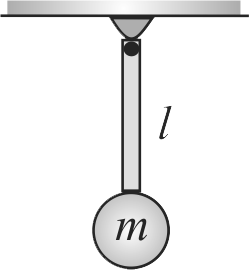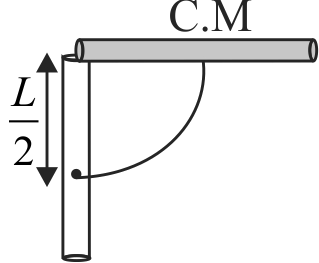366246 A solid sphere of mass \(\mathrm{m}\) and ratio \(R\) is rotating about its diameter. A solid cylinder of the same mass and same radius is also rotating about its geometrical axis with an angular speed twice that of the sphere. The ratio of their kinetic energies of rotation \(\left( {{E_{{\rm{sphere }}}}/{E_{{\rm{cylinder }}}}} \right)\) will be
366248
A rigid rod of length \({l}\) and negligible mass has a ball of mass \({m}\) attached to one end with its other end fixed, to form a pendulum as shown in figure. The pendulum is inverted, with the rod vertically up, and then released. Find the tension in the rod at the lowest point of the trajectory of ball.
366250 A ring and a disc of different masses are rotating with the same kinetic energy. If we apply a retarding torque \(\tau\) on the ring, it stops after completing \(n\) revolutions in all. If same torque is applied to the disc, how many revolutions would it complete in all before stopping?
366246 A solid sphere of mass \(\mathrm{m}\) and ratio \(R\) is rotating about its diameter. A solid cylinder of the same mass and same radius is also rotating about its geometrical axis with an angular speed twice that of the sphere. The ratio of their kinetic energies of rotation \(\left( {{E_{{\rm{sphere }}}}/{E_{{\rm{cylinder }}}}} \right)\) will be
366248
A rigid rod of length \({l}\) and negligible mass has a ball of mass \({m}\) attached to one end with its other end fixed, to form a pendulum as shown in figure. The pendulum is inverted, with the rod vertically up, and then released. Find the tension in the rod at the lowest point of the trajectory of ball.
366250 A ring and a disc of different masses are rotating with the same kinetic energy. If we apply a retarding torque \(\tau\) on the ring, it stops after completing \(n\) revolutions in all. If same torque is applied to the disc, how many revolutions would it complete in all before stopping?
366246 A solid sphere of mass \(\mathrm{m}\) and ratio \(R\) is rotating about its diameter. A solid cylinder of the same mass and same radius is also rotating about its geometrical axis with an angular speed twice that of the sphere. The ratio of their kinetic energies of rotation \(\left( {{E_{{\rm{sphere }}}}/{E_{{\rm{cylinder }}}}} \right)\) will be
366248
A rigid rod of length \({l}\) and negligible mass has a ball of mass \({m}\) attached to one end with its other end fixed, to form a pendulum as shown in figure. The pendulum is inverted, with the rod vertically up, and then released. Find the tension in the rod at the lowest point of the trajectory of ball.
366250 A ring and a disc of different masses are rotating with the same kinetic energy. If we apply a retarding torque \(\tau\) on the ring, it stops after completing \(n\) revolutions in all. If same torque is applied to the disc, how many revolutions would it complete in all before stopping?
366246 A solid sphere of mass \(\mathrm{m}\) and ratio \(R\) is rotating about its diameter. A solid cylinder of the same mass and same radius is also rotating about its geometrical axis with an angular speed twice that of the sphere. The ratio of their kinetic energies of rotation \(\left( {{E_{{\rm{sphere }}}}/{E_{{\rm{cylinder }}}}} \right)\) will be
366248
A rigid rod of length \({l}\) and negligible mass has a ball of mass \({m}\) attached to one end with its other end fixed, to form a pendulum as shown in figure. The pendulum is inverted, with the rod vertically up, and then released. Find the tension in the rod at the lowest point of the trajectory of ball.
366250 A ring and a disc of different masses are rotating with the same kinetic energy. If we apply a retarding torque \(\tau\) on the ring, it stops after completing \(n\) revolutions in all. If same torque is applied to the disc, how many revolutions would it complete in all before stopping?
366246 A solid sphere of mass \(\mathrm{m}\) and ratio \(R\) is rotating about its diameter. A solid cylinder of the same mass and same radius is also rotating about its geometrical axis with an angular speed twice that of the sphere. The ratio of their kinetic energies of rotation \(\left( {{E_{{\rm{sphere }}}}/{E_{{\rm{cylinder }}}}} \right)\) will be
366248
A rigid rod of length \({l}\) and negligible mass has a ball of mass \({m}\) attached to one end with its other end fixed, to form a pendulum as shown in figure. The pendulum is inverted, with the rod vertically up, and then released. Find the tension in the rod at the lowest point of the trajectory of ball.
366250 A ring and a disc of different masses are rotating with the same kinetic energy. If we apply a retarding torque \(\tau\) on the ring, it stops after completing \(n\) revolutions in all. If same torque is applied to the disc, how many revolutions would it complete in all before stopping?
